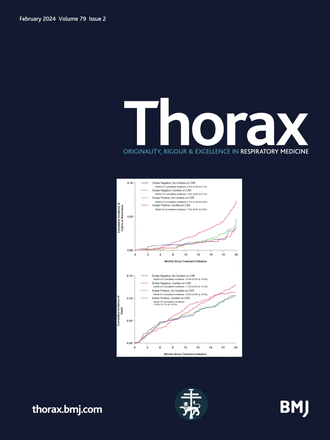Variability in sensitivity to inflammation in muscle and lung of patients with COPD may underlie susceptibility to lung function decline
IF 7.7
1区 医学
Q1 RESPIRATORY SYSTEM
引用次数: 0
Abstract
Background Muscle wasting and weakness (sarcopenia) are commonly associated with COPD causing frailty and reduced quality of life. The contribution of inflammation to muscle loss and the susceptibility to rapid lung function decline is debated. We hypothesised that comparing the muscle transcriptome to circulating inflammatory cytokine profiles in patients would identify any contribution of systemic inflammation to muscle atrophy. Methods Quadriceps differential gene expression was determined between mild-COPD (n=28) and severe-COPD (n=51) using GSE100281. These microarray data were compared by biweight mid-correlation with lung function and plasma cytokine levels from the same patients. Results Patients with severe COPD had reduced fat-free mass index (a measurement of muscle mass) compared with patients with mild COPD despite similar physical activity and inflammatory cytokine levels. Gene sets associated with inflammation and epithelial mesenchymal transition (EMT) were elevated in severe COPD, suggesting that inflammation may contribute to the loss of muscle mass. In patients with severe COPD, EMT and inflammation gene sets were strongly associated with circulating proinflammatory and anti-inflammatory cytokines. However, in patients with mild COPD, anti-inflammatory cytokines showed negative associations with these gene sets and associations with proinflammatory cytokines were weak. In data from lung and blood samples, patients with severe COPD had elevated inflammatory and EMT gene expression compared with patients with mild COPD suggesting that this phenomenon is not muscle-specific. Conclusions In patients at the severe end of the COPD spectrum, the proinflammatory response in muscle predominates, whereas in patients at the mild end of the spectrum, the anti-inflammatory response predominates. This suggestion needs confirming in a longitudinal cohort. Data are available on reasonable request. The array data sets containing the expression data are freely available on the NCBI gene expression omnibus (慢性阻塞性肺病患者对肌肉和肺部炎症敏感性的变异性可能是肺功能下降的易感性的基础
背景:肌肉萎缩和无力(肌肉减少症)通常与慢性阻塞性肺病相关,导致身体虚弱和生活质量下降。炎症对肌肉损失的贡献和对肺功能快速下降的易感性是有争议的。我们假设,将患者的肌肉转录组与循环炎症细胞因子谱进行比较,将确定全身性炎症对肌肉萎缩的任何贡献。方法采用GSE100281检测轻度copd (n=28)和重度copd (n=51)患者股四头肌差异基因表达。将这些微阵列数据与同一患者的肺功能和血浆细胞因子水平进行双权重中相关性比较。结果:与轻度COPD患者相比,重度COPD患者的无脂质量指数(一种肌肉质量的测量)降低,尽管身体活动和炎症细胞因子水平相似。与炎症和上皮间充质转化(EMT)相关的基因组在严重COPD中升高,表明炎症可能导致肌肉质量的损失。在严重COPD患者中,EMT和炎症基因组与循环促炎和抗炎细胞因子密切相关。然而,在轻度COPD患者中,抗炎细胞因子与这些基因组呈负相关,与促炎细胞因子的相关性较弱。在肺和血液样本的数据中,与轻度COPD患者相比,重度COPD患者的炎症和EMT基因表达升高,这表明这种现象不是肌肉特异性的。结论在COPD谱系的重度患者中,肌肉的促炎反应占主导地位,而在轻度患者中,抗炎反应占主导地位。这一建议需要在纵向队列中得到证实。如有合理要求,可提供资料。包含表达数据的数组数据集可在NCBI基因表达综合数据库上免费获得()。有关生理和循环细胞因子水平的数据可根据合理要求提供。
本文章由计算机程序翻译,如有差异,请以英文原文为准。
求助全文
约1分钟内获得全文
求助全文
来源期刊

Thorax
医学-呼吸系统
CiteScore
16.10
自引率
2.00%
发文量
197
审稿时长
1 months
期刊介绍:
Thorax stands as one of the premier respiratory medicine journals globally, featuring clinical and experimental research articles spanning respiratory medicine, pediatrics, immunology, pharmacology, pathology, and surgery. The journal's mission is to publish noteworthy advancements in scientific understanding that are poised to influence clinical practice significantly. This encompasses articles delving into basic and translational mechanisms applicable to clinical material, covering areas such as cell and molecular biology, genetics, epidemiology, and immunology.
 求助内容:
求助内容: 应助结果提醒方式:
应助结果提醒方式:


